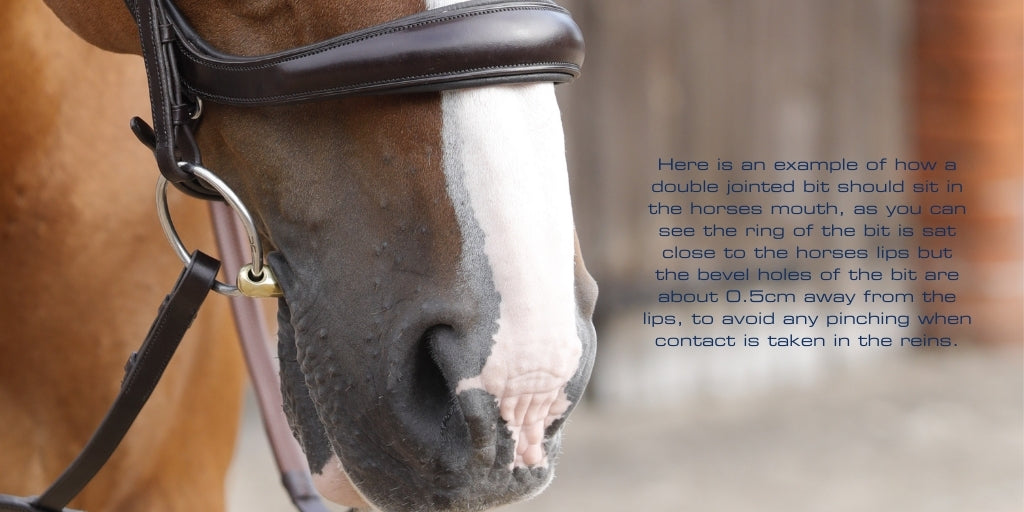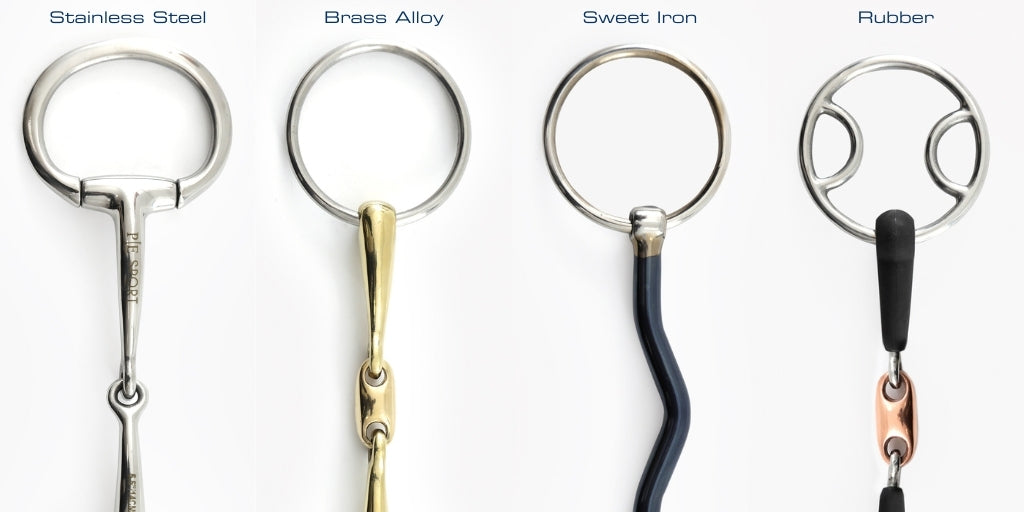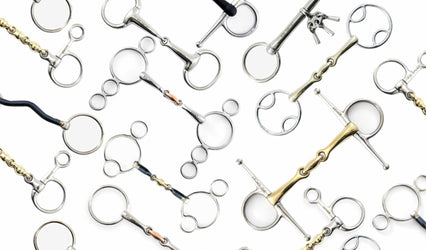Posted
It’s a long process to make the right choice when it comes to selecting and fitting the best bit for your horse. It can seem like something of a minefield. A common tack dilemma that most equestrians have encountered throughout the years is which bit should I use for my horse? And how to know if it fits correctly.
Here are our few tips and tricks to help you select the right bit for your horse and check if it fits correctly, but remember that every horse is different.How to measure your horse for the correct bit size.
If your horse currently has a correctly fitting bit but you wish to buy a new one you could simply measure the size of the current one. Remember you are measuring the mouth piece side to side in between the rings.
If it is a new horse or the bit that you currently have doesn’t fit correctly, you can measure your horse’s mouth with a piece of string, fabric tape measure or a thin plastic tube. If you are using string tie a knot in one end, you could also add a bit guard to avoid pulling the string completely through the horse's mouth. Put the string through your horse’s mouth with the knot sitting on the outside of the lips on one side. On the other side mark onto the string with a pen or piece of tape where it meets the outside of the lips (ask a friend for help if needed). Once this has been done measure the distance between the knot and the mark/tape and this is the size of bit that you will need. If your horse is in between sizes we would suggest going up a size as a bit that is slightly bigger is better than one that is too small and may pinch your horses’ lips.
Once you have this measurement use the guide below to determine which bit would be best for your horse.

How to check if your new bit fits.
There used to be a general rule of leaving one finger’s width of space between your horse’s lips and the cheeks of the bit. In the past when all you could get was a single link bit, this rule stood pretty firm, however, nowadays there are a variety of different mouthpieces and the fit will vary slightly with each different type.
No joint: These bits need to sit fairly flush with the sides of the face. Most horses will take a slightly smaller size in a Mullen bit than a jointed bit, as there is no need to allow for the bend in the mouth as the jointed bit folds around the jaw. If the bit is too big it will slide from side to side in the mouth, which is a distraction and with a port, can be very uncomfortable for the horse.
Single joint: When fitting this bit, the general rule still applies and there should be a finger width (1cm -1.5cm) on both sides, between the lips and the cheeks of the bit on each side.
Double joint: These bits don’t have the folding action of a single jointed bit, so when fitting this bit, it’s important that you don’t have too much room between the bit and the lips, or when a contact is taken there will be too much bit and this will cause excessive side to side movement in the mouth. If it is a loose ring, so long as the lips are 0.5 of a cm clear of the bevel holes, then with the contact applied there should be plenty of room to avoid pinching of the lips.
Double bit sets: A general rule of thumb, your bradoon size is the same as your normal snaffle bit and will generally sit in the same place as your snaffle, though some horses fit the double better with their bradoon a ¼ inch bigger to give more room in the mouth for the two bits. Your Weymouth bit will be a ¼ inch size smaller. It is a ported bit, so needs to sit quite flush and it also sits on the slightly narrower, lower part of the jaw

There are many factors to take into consideration when choosing your bit:
Choosing the thickness:
To start; consider the thickness.
When taking into consideration the thickness of a bit you should also consider the size of the horses/ pony’s mouth as a thicker bit may not suit the conformation of your horse’s mouth.
The thinner the mouthpiece, the more the horse will feel the effect of the rein pressure. Thinner bits should encourage more of a reaction to the contact.
Thicker bits are often a good option for young horses or horses that have a sensitive mouth as the pressure of a thin bit can be too sharp. If you’re after a thick bit, the Hollow Mouth Eggbutt Snaffle could be a good option as it’s 21mm wide. The thickness of all of our bits can be found in the product description (measurement A).
Choosing the mouthpiece:
No joints: These bits are also known as straight bar or Mullen mouth (or ported) bit and have no joint in them. Check out our Blue Sweet Iron Loose Ring Mullen Mouth Snaffle.
Single jointed: This is a common two-piece mouthpiece. The joint in the mouth piece allows the rider to apply pressure to one side of the mouth more than the other. These bits can, however, have a nutcracker effect, when the bit moves the joint will move up and down. This could be a problem for a horse with little room between their tongue and roof of the mouth as it can clash with the roof of the horse’s mouth or the tongue causing discomfort. Take a look at our Jointed Flat Ring Eggbutt Snaffle.
Double jointed: These bits are split into different sections with an extra piece in between the two halves. There are different forms the extra piece can take such as a French link (flat) or a lozenge (rounded). These bits reduce the nutcracker effect and are therefore more comfortable for many horses. However, the extra link applies more pressure on the tongue and not all horses like this extra pressure. Take a gander at the Brass Alloy Training Bit with Lozenge.
Roller bits: Some bits have rollers on the mouthpiece. These are movable pieces that the horse can rotate using their tongue. The idea behind these bits is that it encourages the horse to mouth and play with the bit, helping them to become more relaxed in the mouth and jaw resulting in them hopefully being more accepting of the bit. The most common roller bit is the Copper Roller Mouth Dee Bit.
Waterford bit: This bit is comprised of multiple joints and links giving it the appearance of a chain. The entire mouthpiece is movable and encourages a horse to play with the links in their mouth. The bit also encourages the horse to relax and soften the jaw. If the horse attempts to lean or grab hold of the bit the joint collapse and move around preventing this and as a result of this they are typically softer on the reins and therefore reducing them leaning or pulling. In which case the Waterford is a relatively strong and severe bit so is best to be used for those very strong horses*.
*A Waterford bit needs to be ¼ to ½ an inch larger than the horses’ normal bit size to fit correctly as the mouthpiece of the bit needs to curl around the horse’s lips to allow the bit to work to its full potential. Have a glance at our Brass Alloy Hanging Cheek with Waterford Mouth.
Pelham: This bit combines the action of a curb rein with a snaffle bit. The Pelham is more severe than other snaffles as it has a leverage action on the jaw. However, for showing the Pelham is much softer than a double bridle (see next option). The snaffle rein on a Pelham helps to lift the horse's head, and the curb rein helps to encourage flexion. Have a browse of the Double-Jointed Pelham with Copper Lozenge.
Weymouth: Traditionally you would use a Weymouth (also known as a curb) and bradoon. A Weymouth has a ported mouth piece to make room for the tongue. The bradoon is a slimmed down version of a regular snaffle. The bradoon should be ¼ to ½ inch longer to ensure both bits lie flat. Not all horses like the feel of a Weymouth as they take up a lot of room in the horse’s mouth. Take a look at the Port Mouth Weymouth Bit Set.

WARNING there are still more choices to be made!
Choosing the right style of bit ring:
Loose Ring: The rings can rotate through bevel holes in which are attached to the mouthpiece. This allows the mouthpiece some independence from the rein contact in terms of being able to move in with the horse’s tongue and jaw. This action makes it hard for the horse to lean on or take hold of the bit.
Eggbutt: This is a fixed ring option that offers consistency in the mouth. The mouthpiece is less able to follow the movements from the rein contact. Some horses may prefer this consistency while others may find it more restricting and unnatural. A fixed ring isn’t the best option for horses that have the tendency to lean.
Full cheek: This can be a good option for a young or inexperienced horse. The bars that protrude up the cheek help with head direction and turning. When turning, rein pressure applies to one side more than the other, this will encourage the horse to turn with its head, this is useful for horses who are learning to respond to aids or those who try to tilt their heads to avoid pressure on the rein.
Hanging cheek: This option is believed to exert a small amount of poll pressure making it easier for the rider to ask the horse for flexion and softness in the head. Due to this bit staying in a fixed position it can enhance the communication between the horse and the rider.
Gag: There are many different styles of gag with the Dutch gag being one of the most popular. A gag is a leverage bit that applies pressure to the poll. You can simply choose the leverage by the different rings on the bit. Some gags have two or three rings. The lower down the ring you choose, the more leverage you get and therefore greater pressure. Two reins or a rounding should be used with this bit.
Tom Thumb: The tom thumb is a great bit to encourage the horse to improve their head carriage. By adding slight pressure to the poll, it encourages the horse to lower their head. Along with the lower loop on the bit which adds slight pressure to the tongue encouraging the horse to soften their head into the bit.
Bevel: A bevel bit is a way to softly add poll pressure to encourage the horse to soften in the reins, lower their head carriage and gain contact with the bit. The bevel action provides more brake-power so is ideal for those horses who needs something slightly stronger than a snaffle.

LAST STEP! Nearly there…
Choosing the material:
Stainless Steel: This is the most common material that horse bits are made from. These bits do not rust and have a neutral taste. Check out our range of Stainless Steel Horse Bits.
Copper/Brass Alloy: When your horse's saliva reacts with copper it causes the metal to rust. This makes the bit give off a sweet taste. Some horses also like the warmer feel in the mouth than a stainless steel one. Brass alloy bits are alloyed with copper to produce a strong durable metal. Check out our range of Brass Alloy Horse Bits.
Sweet Iron: These bits will rust when in contact with your horse's saliva, this in turn creates a sweet flavour that should encourage them to produce more saliva and mouth on the bit. Most horses enjoy the taste of this bit. And don’t be alarmed if it changes colour, that is the rust and this is meant to happen. Check out our range of Sweet Iron Horse Bits.
Rubber: These lightweight but strong coverings are normally found on stainless steel bits. These bits are good for horses that don’t like the cold sensation of metal in their mouth. Some of these bits might have a flavour to encourage mouthing and salivation. These might not be the best bit if you have a horse who chews heavily on their bit as these may become out of shape and teeth marks can make a rough surface, meaning the bit will need to be replaced more frequently. Check out our range of Rubber Horse Bits.

This concludes the end of our guide to selecting and fitting your Premier Equine Horse Bit. If you are still struggling to determine which bit would best suit your horse you may want to seek out the advise of a professional bitting specialist who will be able to advise you further.
Pair our horse bits with our wonderful range of Anatomical Bridles and Reins.


